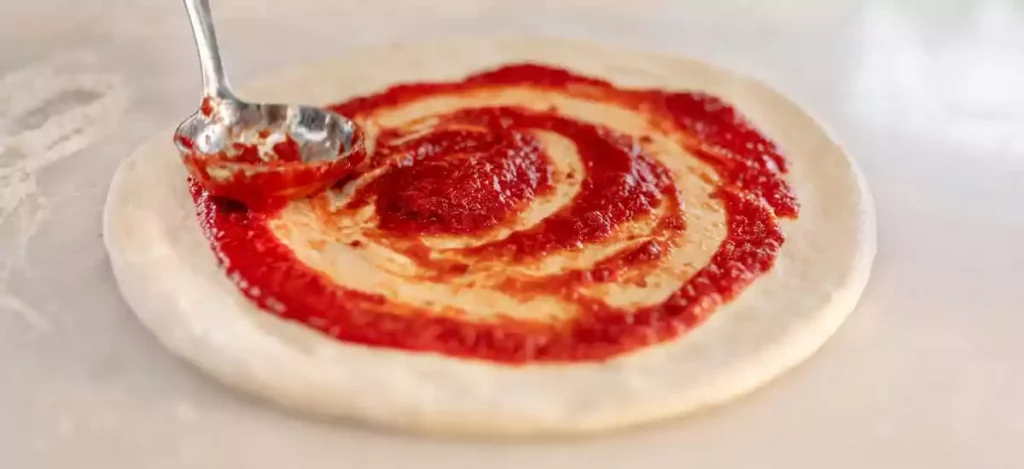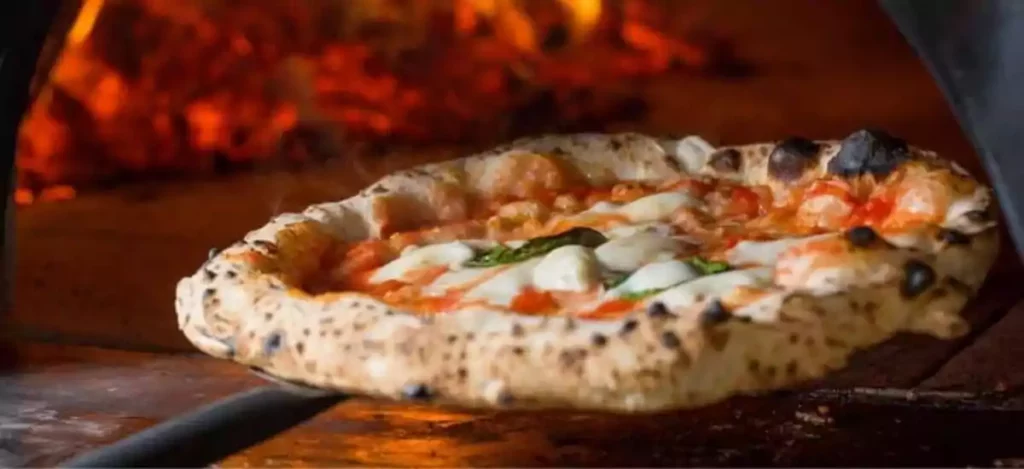A great pizza can be elusive. It would help if you had an excellent dough recipe, proofed dough, a pizza peel, toppings, and (some would say) getting the pizza off the peel and into the oven. There are many ways your perfect pizza might go wrong, and if you add hungry visitors, you’ll be a dissatisfied cook. One of the main problem is when Bottom Of Pizza Not Cooking
There are many ways your perfect pizza might go wrong, and if you add hungry visitors, you’ll be a dissatisfied cook. Take a deep breath and relax. Speak about pizza problems and solutions.
How To Tell If Pizza Is Undercooked?
Because overcooked pizza is annoying and harmful, you should instead focus on eating undercooked pizza is a waste of time and energy. If you don’t want to upset your stomach after eating a pizza, be sure it’s been adequately cooked before taking a bite! As a result, are you ready to learn about the signs that your pizza is undercooked? Alternatively,
- The First Step Is To Look For Raw Parts.
If you find any uncooked dough on your pie, your first step should be to discard it. It would help if you inspected the bottom of the pizza because it will be covered in cheese, vegetables, and other toppings.
You’ll need to raise it and inspect the bottom to do this. A golden-brown crust indicates that the pizza has been cooked thoroughly. Contrary to what you would think, undercooked bread has a white crust.
- Toppings And Condiments
Another possible explanation for your pizza’s underdone state is an overabundance of sauce. Undercooked pizza is almost always the result of using too much sauce. Although the sauce is delicious, the pizza will be undercooked if you use too much. So, maintain a mild sauce to ensure that the pizza cooks evenly.

- Unnecessary Additives
An undercooked pizza is more likely to have too many things on it. Most of the time, the pizza will be undercooked or have irregular cooking patterns. You must use as many ingredients as necessary to ensure that the dough or crust receives sufficient heat waves to be thoroughly baked.
Pizza with a thin crust and a thick layer of toppings is more likely to be undercooked. Adding too many ingredients or toppings can result in an uncooked pizza; plan accordingly.
- The Solution To The Pizza That Wasn’t Fully Cooked.
Avoid using a convection oven when mending the uncooked pizza because it could burn the pizza. To guarantee that the pizza is cooked to perfection, you can either reduce or move the oven’s temperature or rack.
Remove the ingredients and bake for over 10 minutes in the oven using a slow cooker. You can re-heat the mixture after the crust has baked and added the other ingredients. This method will ensure that the pizza is cooked to perfection without drying out the contents.
6 Reasons Why The Bottom Of Pizza Not Browning
There are six reasons why the bottom of the pizza is not browning and ways to solve these problems.
1. Baking Temperature Is Incorrect
Remember that different pizza styles bake at different temperatures.
The fundamental difference between pizzas is thickness. Therefore a thicker pizza needs to bake at a lower temperature. You must be able to change your oven’s temperature to cook the proper pizza.
Some pizzas demand high heat, while others need a lower temperature to bake correctly. Pizzas include Sicilian and Detroit. Both are thicker than regular pizza and take longer to bake.
This extended baking time demands a lower temperature, so the exterior doesn’t burn before the interior is done.
Fixes: Adjust the temperature
- Think about the pizza style and oven you’re using. If you’re using a hot wood-fired oven, you may want to avoid more enormous pizzas and opt for thin-crust Italian.
- If you’re using a regular home oven, you’ll have reasonable control over its temperature to alter it for the pizza you’re creating.
- Suppose your thin pizza isn’t baking through; up the oven temperature to bake it faster. Similarly, if your thick pizza seems done before the interior is, lower the temperature and bake it longer.

2. The Toppings Are Too Wet
If you use wet toppings, your pizza foundation won’t bake correctly and will be soggy. Many newbies fill their pizza with as much as possible and expect it will bake. Too much fresh mozzarella and high-moisture vegetables can make a pizza mushy.
A pizza can only withstand minimal moisture before the dough sogs. Thicker pizzas can tolerate additional toppings, but not if they’re too wet.
Fixes: Fewer Toppings and Use drier toppings
- For a perfectly baked pizza, use a little sauce and cheese. By using less, you reduce the chance of the dough becoming mushy.
- Once you’re pleased with your basic pizzas, you can go on to more complicated suitable for your pizza.
- If you want to load up the pizza without a soggy base, you’ll have to do it differently. Since most components are the enemy, try to avoid them.
- The wet sauce will spoil your pizza, so make it as thick as possible and use less of it. Some individuals add too much sauce, so use less than you think.
- Thickening pizza sauce is easy. It can be done at low heat in a skillet, filtered through a sieve, or blended with tinned whole tomatoes without the tin water.
- Try low-moisture mozzarella instead of fresh. As the name implies, it contains less water, so won’t sog the pizza.
- Time to choose toppings. Avoid high-moisture vegetables and fruits on most pizzas, but you can use them. You can boil certain vegetables to remove moisture before adding them to pizza.
Also Read:
How Long Can You Keep Pizza In The Fridge?,
Can You Put Cardboard In The Oven?
3. The Dough You Are Using Cold
Many people refrigerate the dough to reduce its rise and generate more taste. It enhances dough, but it can do two things that destroy pizza. Cold gluten is tighter and harder to stretch. This hinders you from making the dough as thin as possible, making it bakes longer.
Second, the lower dough temperature increases baking time since it takes longer to reach the necessary baking temperature. It’s not a good idea to bake cold dough.
Fixes: Let the dough reach room temperature
- Allow your dough to warm up before shaping and baking it.
- This can take 30-90 minutes, depending on how warm your home is, but it’s worth it.
- It will be easier to stretch and bake faster by warming the dough.

4. Sauces Were Added Too Early Before Baking
Add pizza toppings as late as possible before baking. Add them later for a better crust. If you add toppings too early, you can run into two fundamental problems: Wet dough. When the pizza sauce settles on the dough, it makes it soggy. The pizza base may remain soggy even after a longer bake. Dough sticks to a pizza peel. If your topped dough has sat on the peel for too long, it may be stuck and won’t slide into the oven. It would help if you avoid this, trust me.
Fixes: Add toppings before baking and Parbake base before toppings
- Best outcomes come from adding toppings just before baking the pizza.
- By adding them as late as possible, you restrict the time they sit on the uncooked dough, helping to reduce sogginess.
- Instead of placing the pizza in the oven fully topped, some individuals partially top it and add toppings while cooking, or they par-bake the base before topping it and putting it back in.
- Parbaking the foundation ensures that the surface is done and won’t get mushy when topped.
- To par-bake, bake it until the surface is dry to the touch.
5. The Oven Wasn’t Heated Long Enough
People often don’t preheat their oven adequately. High heat cooks thin-to-medium crust pizza quickly. People believe that preheating their oven for pizza for 15-20 minutes is sufficient. Think about what you’re using and if it’s healthy. The problem is that the oven won’t be as hot everywhere, so it won’t bake the pizza as well as it could.
Get the oven hot, especially if you’re using a baking stone or steel. If you don’t preheat it properly, it will bake unevenly and take longer.
Fixes: Preheat oven for 1 hour
- For proper heating, preheat your oven for 60 minutes. It’s a long time, so prepare toppings and sides for the pizzas.
- This prolonged preheating period helps the oven reach temperature and allows your baking steel/stone to retain heat.

6. The Base Of Your Thin Pizza Is Too Thick
So you may be trying to make a thin pizza but making it too thick. If you bake it like a thin pizza, the inside will be raw when the outside is done.
The pizza looks impressive until you cut it and see undercooked dough within.
If you don’t know how thin the dough should be, you’ll probably overestimate it. Pizza dough is sometimes thin.
Fixes: Stretch out dough
- Stretch it out if you’re baking your pizza at the highest temperature possible.
- It bakes faster and won’t be raw inside as it’s thinner.
- Now, stretching pizza dough even thinner may seem unattainable to some, which is fair as it can be challenging if you don’t know-how.
- Too much rough dough handling before stretching will stiffen the gluten, making it harder to stretch. Since gluten is tighter, stretching it is easier.
- Instead of trying to thin the dough, let it rest for 5-10 minutes so the gluten may relax. Resting the dough makes it softer and simpler to form.
- Also, the dough’s gluten will be tight if it’s cold, so let it warm up to room temperature before stretching it.
Burnt On A Cheese Pizza?
Many things can result in a burned pizza bottom, but the most likely one is excessive heat escaping from the bottom of the dish. Other problems could be caused by excessive sugar in your dough or much flour on the underside of the dough.

How To Tell If The Dough Is Raw?
Cooking the top but not cooking the bottom suggests that you’ve got enough heat on top but not enough on the bottom. It is essential to have an adequately heated pizza stone or steel while making your pizza so that the crust cooks evenly.
A lower oven rack or reduced heat will allow you to cook for more extended periods without risking overcooking the top.
FAQS
Why Does My Frozen Not Cooked In The Middle?
The frozen product is likely the basis for the suggested cooking temperatures and timeframes. Anyone’s guess is how much thawed food you’ve left out of the freezer while heating your oven. This doesn’t account for oven uniformity.
Is Eating Uncooked Pizza Dough Bad ?
If you keep your homemade pizza dough in the refrigerator, it will only last 4 to 24 hours before it becomes unusable due to drying out. A few days in the fridge and up to three months in the freezer are the best options for keeping it fresh. Make sure to keep in mind that more yeast will speed up deterioration. Undercooked pizza dough might make you sick.
How Do You Soften Hard Pizza Dough?
Your crust can be softer by sprinkling it with water before cooking your pizza. A lovely wet texture may be achieved by using this procedure. You shouldn’t immediately add water to the dish when it’s out of the oven. Otherwise, the water would be absorbed by the hot pizza.
Read More:
What Is A Well Done Pizza?,
How Long Does Pizza Sauce Last In The Fridge?
what is brooklyn style pizza
How big is a 12 inch pizza?



